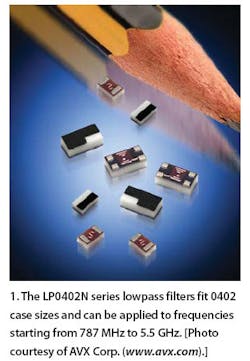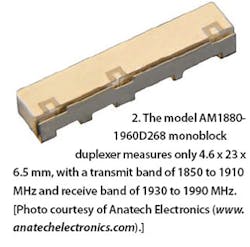RF/Microwave Filters Fit Surface-Mount Needs
This file type includes high resolution graphics and schematics when applicable.
Filters are getting smaller, with RF and microwave designers having a greater number of choices in surface-mount packages. These miniature filters leverage a variety of technologies, including traditional inductive-capacitive (LC), ceramic, surface-acoustic-wave (SAW), bulkacoustic- wave (BAW), film-bulk-acoustic- resonator (FBAR), microelectromechanical- systems (MEMS), and even monolithic-microwave-integratedcircuit (MMIC) approaches.
Specifying a miniature filter calls for a review of basic performance requirements, such as passband frequencies, insertion loss, rejection, and VSWR; a review of the key filter specifications can be found in the RF Primer in the April 2010 issue (p. 42) of Microwaves & RF. Other than LC and ceramic filters, many of the surface-mount filter types are formed with semiconductor-type processing, using thin substrate wafers and photolithography techniques.
Dielectric Laboratories, for example, offers high-performance ceramic materials and capacitors, but can also fabricate filters on its materials, with total coverage from 30 MHz to 67 GHz. It also offers guidance to those seeking a filter, in the form of its "RF Guru" system for thin-film filters. Similarly, K & L Microwave provides access on its web site to its free K & L Filter Wizard software program, which allows visitors to design their own filters. The company's Kel-fil software tool focuses on the design of ceramic-based filters while the Mini-Max selection program has been developed for those in need of custom surface-mount filters.
AVX Corp. has developed harmonic lowpass filters that fit in tiny 0402 cases. Based on multilayer thin-film technology, the firm's LP0402N series of filters (Fig. 1) are designed to pass fundamental frequencies and suppress second- and third-harmonic signals.
The filters can be applied to frequencies starting from 787 MHz to 5.5 GHz.
Although known for ceramic packages, StratEdge also builds ceramic stripline filters through 18 GHz with custom lowpass, highpass, and bandpass responses. Known more for its oscillators and frequency synthesizers, Synergy Microwave Corp. also builds compact surface-mount RF/microwave filters. The company's recent introduction (seeMicrowaves & RF, April 2010 Cover Feature) of electrically tunable inductors clears the way for tunable filters in surface-mount housings. Low-temperature-cofired-ceramic (LTCC) substrates enable the fabrication of extremely small RF/microwave filters. A number of companies manufacture custom and standard LTCC filters in surface-mount packages, including Plextek and Barry Industries. In fact, the latter offers a six-page LTCC design guide on its web site, complete with recommended and optimal line widths, line-to-line spacing, viahole parameters, resistor values, and other information essential to creating an LTCC filter with predictable and repeatable performance. For those seeking to explore the possibilities of LTCC filter technology, Mini-Circuits supplies a "sampler kit" based on its LTCC filters, with five models each of any lowpass LFCN and highpass HFCN LTCC filters, from 80 MHz to 13 GHz.
TriQuint Semiconductor applied its expertise in semiconductor fabrication to produce selective 2.4-GHz Wi-Fi/WiMAX filters based on BAW technology. The filters allow a single wireless device to serve Wi-Fi and WiMAX applications. Using MMIC technology, Hittite Microwave has developed lowpass and bandpass filters with varactor-based electronic tuning across passbands from 1.0 to 7.6 GHz. They are housed in 5 x 5 mm surfacemount packages.
Anatech Electronics, which features an extensive line of microwave filters for high-power applications, also supplies surface-mount filters such as the model AM1880-1960D268 monoblock ceramic duplexer for wireless base stations (Fig. 2).
It measures 4.6 x 23 x 6.5 mm but handles inputs to 2 W. It has a transmit band of 1850 to 1910 MHz and receive band of 1930 to 1990 MHz.
As filters get smaller, integrated assemblies can also be made smaller. As an example, model 3IFAX-1100/2250- ML (Fig. 3) is a two-channel switch filter bank with a bypass channel.
Developed by Lorch Microwave. it has a low band from 20 to 1100 MHz and high band of 1300 to 2250 MHz. The bypass runs 1300 to 2250 MHz. The It measures 3.2 x 1.9 x 0.35 in.
This file type includes high resolution graphics and schematics when applicable.
About the Author
Jack Browne
Technical Contributor
Jack Browne, Technical Contributor, has worked in technical publishing for over 30 years. He managed the content and production of three technical journals while at the American Institute of Physics, including Medical Physics and the Journal of Vacuum Science & Technology. He has been a Publisher and Editor for Penton Media, started the firm’s Wireless Symposium & Exhibition trade show in 1993, and currently serves as Technical Contributor for that company's Microwaves & RF magazine. Browne, who holds a BS in Mathematics from City College of New York and BA degrees in English and Philosophy from Fordham University, is a member of the IEEE.




